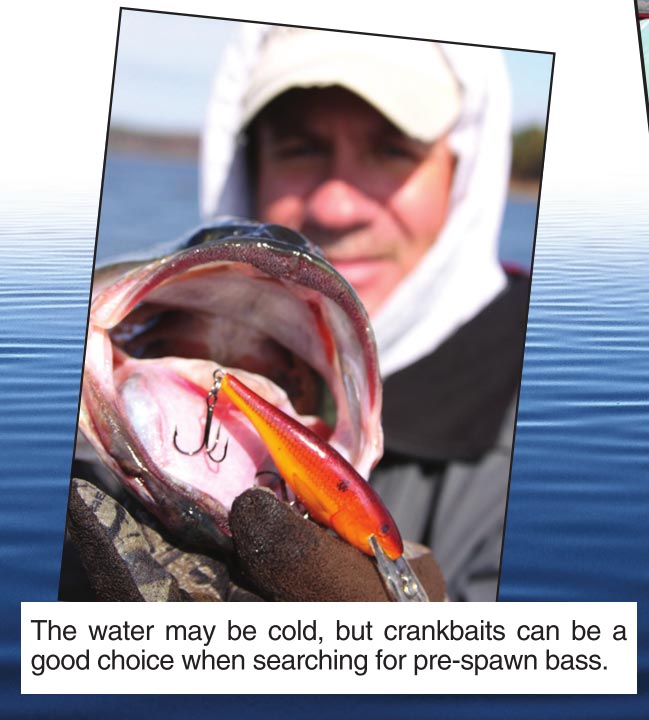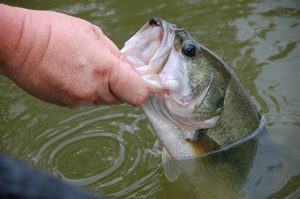Try these tips when the open water bass season arrives
By Louie Stout
Contributing Writer
The long winter is passing, and it’s time to turn those bassin’ fantasies into real life experiences.
Of course, some parts of Outdoors News country may still be under ice or state regulations that prohibit anglers from fishing for bass until early summer.
Regardless of your status, it’s never too early to take a refresher course for catching bass in the coming months. Here are our eight tips for getting the season going in the right direction:
1 Don’t wait too long
You can score some fast bass action not long after the ice leaves the lake. Granted, you probably won’t find a lot of bass shallow early on; deeper holes will have them schooled up and ready to bite. Avoid those areas near current and look for deeper holes nearest traditional spawning areas.
The best technique for this cold-water season is fishing a blade bait (commonly called Silver Buddy) or even a Rapala Jigging Rap. Once you locate bass or baitfish on your electronics, fish these baits vertically over the top of them.
2 Play the weather
You can catch bass in the holes when it’s cold nasty, but look for some to move up during warming trends. Some may move to the bank, but most will pull against the edges of drop offs. Again, look for those areas nearest spawning grounds. Inside turns, where the drop off creates a wedge into a flat, are good places to start.
3 Monitor water temperature
A thermometer is worth its weight in gold during the early in the season. An increase as  little as one or two degrees in the water temperature can make a big difference.
little as one or two degrees in the water temperature can make a big difference.
Typically, the northern side of the lake gets the most sunshine, hence it warms up faster, especially if there are rocks or seawalls to absorb and hold that heat. Big pre-spawn females seek out the warmer water to help promote egg maturity before spawning. They will move up during the warmest part of the day.
4 Hit pad areas early
One commonly overlooked area is bays where the lily pads haven’t yet sprouted. Those shallow areas usually have black, mucky bottoms and, on a couple of sunny days, can heat up as much as 10 degrees more than the rest of the lake. Bass and baitfish will seek them out. That’s a good place to pitch lightweight skirted jigs tipped with small plastic trailers or wind spinnerbaits around the orange pad roots. If the fish aren’t there, look for similar areas or check back in a few days.
5 Fish horizontally
Anglers have a tendency to fish slow and with bottom-bouncing finesse tactics when the water is cold.
That’s not an efficient way to find fish when it’s starting to warm up.
On northern lakes, crankbaits fished along the deep side of flats can be a great way to locate and catch bass. You can have some great days on fast-moving plugs when the water is still below 50 degrees. When fishing with a friend, one angler should fish along the drop-off with a crankbait, while his partner hurls lipless crankbaits up on the flats.
6 Watch moon phase
Biologists have told us that bass spawn when the water hits 72 degrees. The truth is the full moon phase a lot more to do with it.
Some bass are just genetically wired to spawn sooner and in water tempers below 70 degrees. Of course, smallmouth spawn before most largemouth bed, but the largemouth will start nesting sooner than most people believe. When you get a full moon, start watching for bedding bass.
But remember: Big bass produce offspring that often grow bigger than average bass. Immediately releasing any bedding bass you catch helps ensure that lake will continue to produce quality bass fishing.
7 Post-spawn savvy
Contrary to popular belief, bass don’t leave spawning areas immediately after they come off the nest.
Females, exhausted from the ritual, will stay in the same general area but will hole-up in cover until they recover. It may be a nearby boat dock, a thick pod of vegetation or a brush pile near the bank. And they will bite lures!
The males linger on nests longer to guard the eggs, but once they hatch, daddy bass will cruise beneath the pods of tiny bass as they drift with the wind or current or take up temporary residence in and around cover.
Neither post-spawn largemouth females nor males are in a chasing mood, so this is where baits that stay in strike zone longer pay off. Topwaters like rubber frogs or popping styles that can be walked in place are good bets.
So is a wacky-rigged stickworm. Fish them weightless so they fall slowly in the strike zone. Bottom bouncing baits might work, but those lures that stay up in the water column for longer periods of time tend to be better.
8 Low-pressure bass on those hot summer days
Sure you can find bass shallow when the lake warms into the 70s and 80s. But some of the least pressured bass are those that live off shore and follow the big schools of bluegills, perch, alewives, or other small fish that roam out deep.
This is when idling around and watching your electronics for big schools of panfish can lead you to the mother lode of bass. They may be deep – 20 feet or more – and those are the fish that get less fishing pressure, especially during midday hours.
Look for deep-growing vegetation such as perch grass that will hold the fish in one area. Try fishing drop-shot rigs with soft plastics or dragging jigs through the short-cropped aquatic plants. A deep crankbait, slow-rolled spinnerbait, or a swimbait that mimics prominent forage base will work, too.






